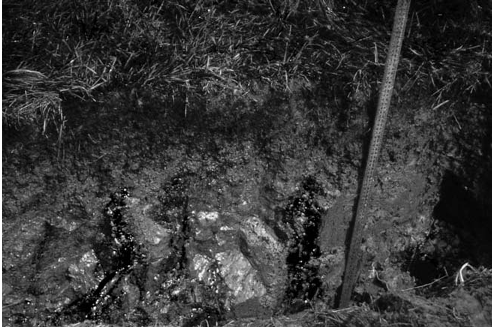Q2. Why is the flow-restraining force assumed according to the material-specific retention curve?
Because neither velocity nor acceleration occurs, hydrostatic conditions are assumed according to the material-specific retention curve.
Q3. How many depths were used to record water contents?
Tensiometers and time domain reflectrometry (TDR) [see, for instance, Topp et al., 1980] were used to record capillary potentials and volumetric water contents at nine depths.
Q4. What is the main reason why the inverse methods are so sensitive to noise?
Since the inverse methods applied can be highly susceptible to overfitting without adequate noise assessment then one can risk misinterpretation of preferential flow when the true cause is inappropriate assessment of signal to noise.
Q5. What techniques have been applied to the study of preferential flow in soil?
Various techniques of tomographic imaging have been applied to the study of preferential flow in soil including X-ray (CT), electrical resistance (ERT), radar and ultrasound.
Q6. What was the main reason for the infiltration into reconstructed soils?
Infiltration into reconstructed soils was mainly through the soil matrix because no macropores had formed since reconstruction.[24]
Q7. What is the range of effects of capillary gradients in the pores?
In smaller pores, capillarity and capillary gradients can play a role in controlling water movement, but the authors expect the range of such effects to be small scale and local.
Q8. What is the need to combine flow measurements with tracer experiments?
At both profile and hillslope scales, there is also a need to combine flow measurements with tracer experiments to test whether assumptions about flow velocities can equally reproduce the celerities controlling the hydrograph.
Q9. Why is it important to use both data types to characterize the response of a plot,?
This is because in order to fully characterize the response of a plot, a field, a hillslope or a catchment, both data types, hydrograph and tracer concentrations are required to allow the differentiation of celerity effects that control the hydrograph response and the distributions of pore water velocities that control the tracer response.
Q10. How can a system of lateral flow be able to cause the displacement of stored water?
Where the soil is saturated, this can be achieved by the propagation of pressure waves through the system, such that the build up of pressure in an upslope macropore link will cause the displacement of stored water into a pathway further downslope.
Q11. What is the main driver for interest in preferential flows and macropores in soils?
As noted earlier one of the primary drivers for interest in preferential flows and macropores in soils was the problem of explaining how pesticides and other sorbing pollutants were being transported to field drains, groundwaters and rivers [Flury, 1996].
Q12. What are the issues in developing an adequate theory to represent water flow in soils with preferential?
The issues in developing an adequate theory to representingwater flow in soils with preferential flow are those of the three functional requirements set out above, in this case for flows dominated by gravity and viscosity rather than capillarity effects.
Q13. What is the main reason why preferential flows are important at the hillslope scale?
It might be difficult to extend knowledge at the hillslope scale to larger catchment scales because of the variability of responses in space and time and the potential for deeper flow pathways to become more significant at the catchment scale [Uchida et al., 2005b; Tromp-van Meerveld et al., 2007; Bachmair and Weiler, 2013].

![Figure 3. Distribution of 215 wetting front velocities determined in situ for 25 soils covering Udalf, Ochrept, Umbrept, Aquod, Ferrod, Humod, and Udult suborders from Germann and Hensel [2006]; and wetting front velocities from (1) al Hagrey et al. [1999], (2) Dubois [1991], and (3) Selker et al. [1992].](/figures/figure-3-distribution-of-215-wetting-front-velocities-3rkydej4.png)



![Figure 4. Wetting front velocity, v, as function of the input rate, q, according to equation (A9). (Data from Hincapi e and Germann [2009b]; figure from Germann [2013], with permission.)](/figures/figure-4-wetting-front-velocity-v-as-function-of-the-input-n0nlilg1.png)